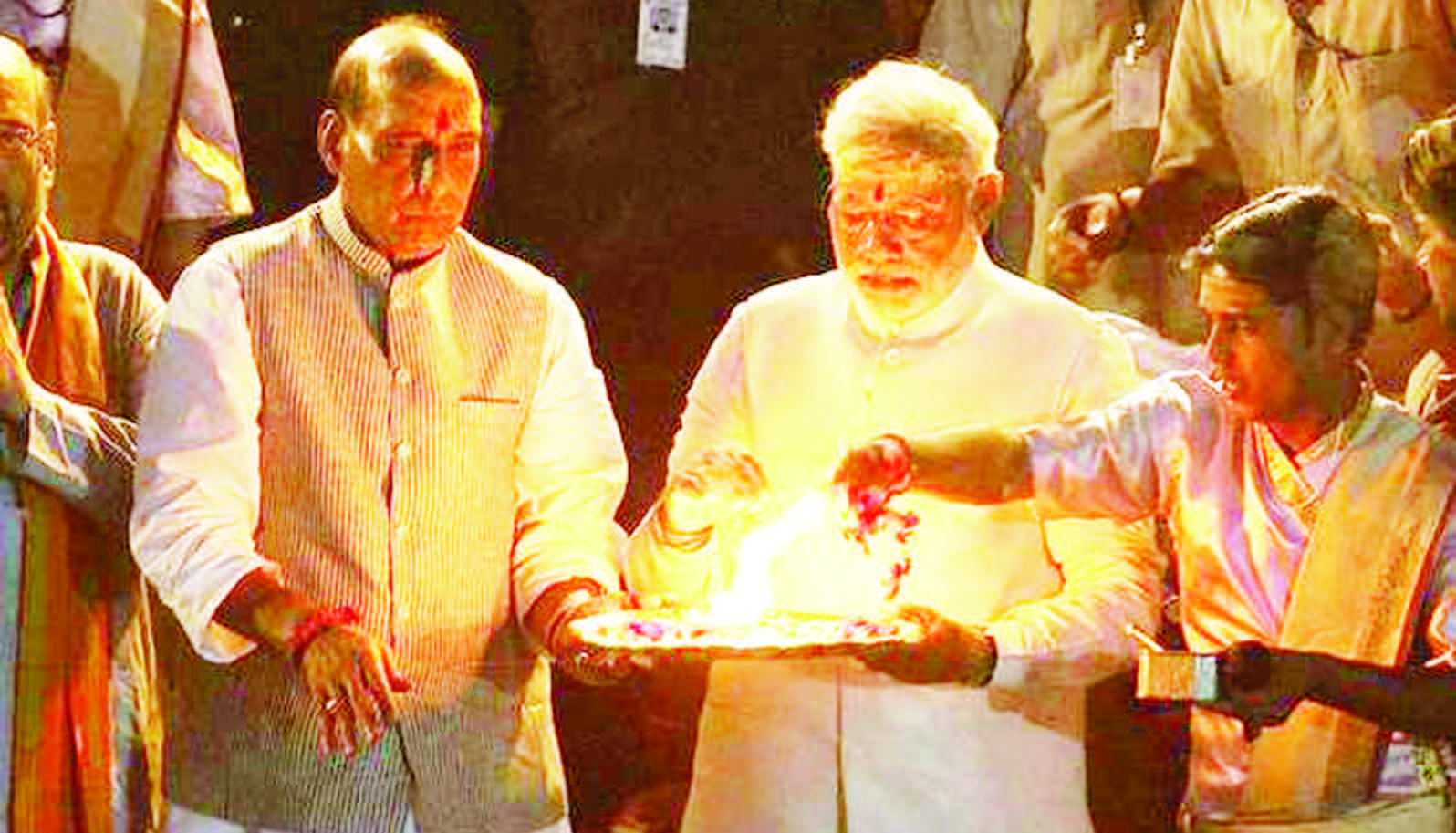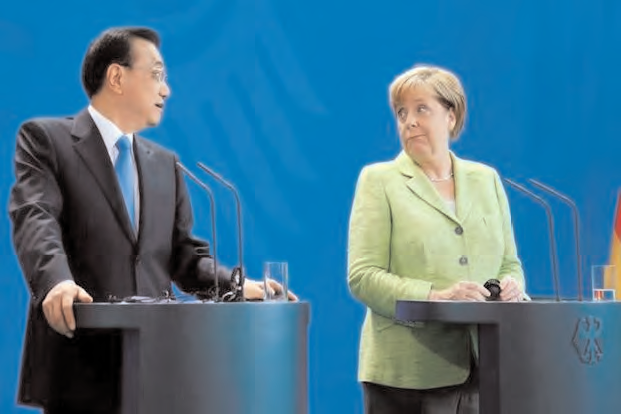
The Hindutva project has succeeded in projecting itself as speaking to the deep diversities that crowd U.P
“The invocation of Shiva and Shakti in this project that hitherto held firmly to a graded order and paternalism would have implications for Indian democracy that have been little envisaged so far”, says the author.
If symbols speak, and in the layered culture deposits of the Gangetic plain they do speak loud, one of the most memorable spectacles was Prime Minister Narendra Modi‘s visit to Kashi Vishwanath Temple on March 4, 2017.
It was preceded by a roadshow in the narrow, winding streets of Varanasi all decked up for the grand effect, following the garlanding of the statue of Pandit Madan Mohan Malaviya at the Benares Hindu University. Within the temple precincts itself Mr. Modi appeared the great performer, oozing a burst of energy, while the archakas were transfixed in the archaic layout of the ancient temple complex. Place this spectacle alongside Mr. Modi’s salutation to ‘Ganga Ma’ at the Dashashwamedh Ghat of the river on May 17, 2014, a day after his victory from Varanasi Lok Sabha constituency, three years ago: and you have before you one of the most powerful symbols to reach out to the length and breadth of India, Shiva and Parvathi, alongside Ganga, and their complex personifications in myriad forms, the principles of dynamism and recreation, galore across India, in much more vivid forms than Ram lalan of Ayodhya.
Yogi Adityanath, the new Chief Minister of Uttar Pradesh, himself heads a temple, the Gorakhnath temple, named after a representation of Lord Shiva, a representation that gathers in its fold elements of Buddhism, the tantra practices, the Nathpanthi traditions, and renouncer cults.
Shiva in political pantheon
While the Hindutva project is unlikely to shed Ram from its political pantheon, it would be worth watching the deployment of Shiva and Shakti sites spread across the length and breadth of the country, particularly in its peripheral regions. Lord Shiva is the lord of the dissenter, the renouncer, the wayward, the very captive of his devotee, the great patron of arts and crafts, the yogi par excellence, while he is at the same time the great destroyer, angry and disdainful of the social order. He inhabits the peripheries of the Brahmanical dispensation that stipulates a tightly ordered social universe. He is primarily the lord of the lower social orders, of the margins. He is the presiding deity across the vast expanses of the Himalayas, most of the southern part of India, and the hills and ghats where the Brahmanical order is precariously present.
For the Hindutva ideologues, at least those who walk hand in hand with Mr. Modi, the conquest of Lord Ram’s place of birth at Ayodhya is over; what is important is to bind India together, its myriad differences and diversities through new bonds. Was the Prime Minister, who said little on the Ram Janmabhoomi issue during his numerous public meetings across the length and breadth of Uttar Pradesh, opening a new front for Hindutva? Are we, therefore, stepping into a religio-political project that was little seen as integral to Hindutva so far?
Finger on the U.P. pulse
The socio-political space that constitutes Uttar Pradesh today has always nurtured a complex internal debate with regard to the idea of India from the later part of 19th century. The great debate with regard to the future of Muslims in the subcontinent following the demise of the Mughal Empire was centred around this region in which the ulema of Deoband and Barelvi madrasas and later the Aligarh Movement played a decisive role.
One always found in this region informal groupings of religious adherents, be they Hindus or Muslims, who did not toe the line of any one political party. Besides, after the abolition of the zamindari system this region, as a whole, was not much shaken up by the powerful agrarian and anti-caste movements that have had such powerful impact in the neighbouring region of Bihar.
However, recent evidence suggests that a large number of traditional upper caste religious groupings in the region have been veering round to the Hindutva project, and orthodoxy has spread its appeal much wider among Muslims. The egalitarian social imaginary of the lower rungs among Hindus has thrown up new modes of religious gatherings, revitalised marginal deities, and much social effort has gone into the construction of shrines and temples and writing caste histories. The Hindutva expressions in this region have reached out to this imaginary while the other political formations in the region have had little say on it.
The cryptic comment that Samajwadi Party leader Mulayam Singh Yadav made, that Chief Minister Akhilesh Yadav’s defeat is on account of his departure from Lohiawad, has a ring of truth about it, although the former himself reached out to this social imaginary very little. The secular hat that the Congress wears is totally disconnected from this groundswell. The Bahujan Samaj Party did little to disabuse the charge that the Prime Minister made in his election rallies that it serves the good of one against its claims to represent the many. Besides, the impermeable walls that the dominant discourse within this party erects across castes and communities makes it difficult for it to access complex modes of oppression and cultural nuances that play a decisive role in an electorally surcharged arena such as Uttar Pradesh.
The strategy
In sum, over the years there has been little attempt to make the deep diversities that crowd Uttar Pradesh speak to one another. The Hindutva project has succeeded in projecting itself as speaking to this diversity through a phalanx of organisations. Mr. Modi was only the presiding deity, the organising centre of this process. The Uttar Pradesh strategy also demonstrates that the Bharatiya Janata Party (BJP) will adopt very distinct strategies in different regions of India, with a few slogans such as ‘Sabka sath, sabka vikas’ as common.
It is a pity to watch the plight of the Muslims in Uttar Pradesh if we ignore the local bravado on display in some places. The Hindutva project has been surreptitiously redefining the Muslim world in this region that has global ramifications. It has selectively extended support to the Sufi heritage, and Mr. Modi even addressed the World Sufi Forum in Delhi in March 2016. It has tried to win over a section of the Shias with an eye on Pakistan, Iran and West Asia, but also tapped the historic Shia-Sunni rivalry in the State to its advantage. It has not been sympathetic to the demand of Aligarh Muslim University for minority status and has expressed strong resentment against the relatively doctrinaire strand of Islam upheld by the Deoband madrasa. Organised Muslim political opinion has largely concentrated in carving out electoral strategies rather than propose ways by which people who subscribe to deep differences in beliefs and values but share much of everyday life in common can live together. The coexistence and toleration argument does not apply here because everyday life is deeply caught in conflicts and the language of sterile secularism does not offer a line of advance.
The language of vikas that the BJP spoke during the electioneering, therefore, may have to be seen through the lens of this expansive Hindutva project. Everyone is welcome to participate in the common economic endeavour, but the normative and cultural codes of such an endeavour will be governed by this project. The invocation of Shiva and Shakti in this project that hitherto held firmly to a graded order and paternalism would have implications for Indian democracy that have been little envisaged so far.
(The author is a former professor at the Centre for Political Studies, Jawaharlal Nehru University, and currently National Fellow, Indian Council of Social Science Research)





Be the first to comment